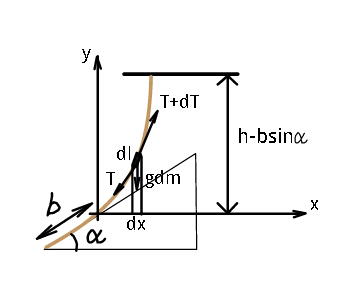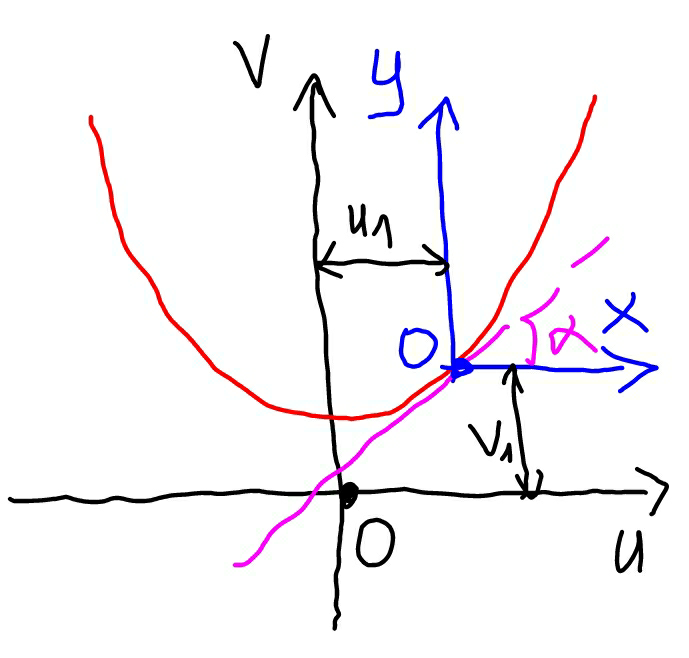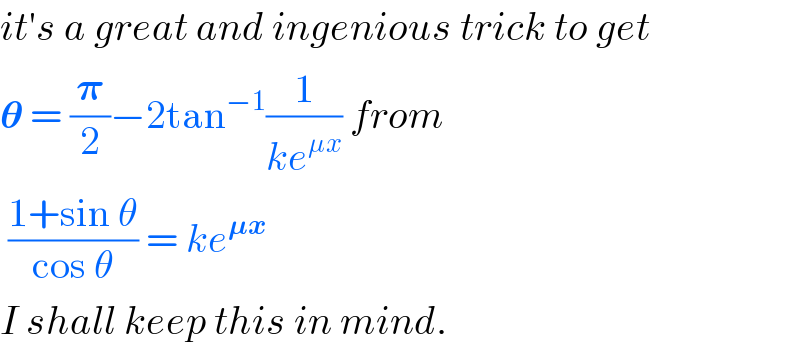
Question and Answers Forum
Question Number 45082 by ajfour last updated on 08/Oct/18

Commented by ajfour last updated on 08/Oct/18

Answered by ajfour last updated on 09/Oct/18
![Tcos θdθ+dTsin θ = λg(dx)sec θ ..(i) dTcos θ = Tsin θdθ ...(ii) ⇒ Tcos θ = T_0 cos α = (λgbsin α)cos α = c from (i) d(Tsin θ)=λg(dx)sec θ ⇒ cos θ d(((csin θ)/(cos θ)))=λgdx ⇒ c∫_(tan α) ^( tan θ) ((d(tan θ))/(√(1+tan^2 θ))) = λgx let tan θ = z ⇒ ∫_z_0 ^( z) (dz/(√(1+z^2 ))) = ((λgx)/c) ln (z+(√(1+z^2 )) )∣_z_0 ^z =((λgx)/c) ln (((z+(√(1+z^2 )))/(tan α+sec α)))= ((λgx)/c) ⇒ z+(√(1+z^2 )) =(sec α+tan α) e^(λgx/c) tan θ+sec θ = ke^(μx) ....(A) k = sec α+tan α ; μ= ((λg)/c) Also sec θ−tan θ = (e^(−μx) /k) ...(B) from eq.(A)−eq.(B): we get tan θ = (dy/dx) = (1/2)(ke^(𝛍x) −(e^(−𝛍x) /k)) y = ((k/(2𝛍))e^(𝛍x) +(1/(2𝛍k))e^(−𝛍x) )∣_0 ^x y= (1/(2𝛍))[(ke^(𝛍x) +(1/(ke^(𝛍x) )))−(k+(1/k)) y=(c/(2𝛌g))[k(e^(𝛍x) −1)+(1/k)(e^(−𝛍x) −1)] y= ((bsin αcos α)/2)[k(e^(μx) −1)+(1/k)(e^(−μx) −1)] where k = sec 𝛂+tan 𝛂 and 𝛍= (1/(bsin 𝛂cos 𝛂)) ⇒ y =bsin 𝛂[cosh (((2x)/(bsin 2𝛂)))+sin 𝛂sinh (((2x)/(bsin 2𝛂)))−1].](Q45087.png)
Commented by MrW3 last updated on 09/Oct/18

Commented by MrW3 last updated on 09/Oct/18
![in coordinate system uv the rope has the equation v=a cosh (u/a) with a=(T_H /(λg))=b sin α cos α=(1/μ) (dv/du)=sinh (u/a) at (u_1 ,v_1 ): sinh (u_1 /a)=tan α ⇒(u_1 /a)=sinh^(−1) (tan α)=ln (tan α+(√(1+tan^2 α))) =ln (tan α+sec α)=ln k v_1 =a cosh (u_1 /a)=a cosh (ln k)=a×((k+(1/k))/2) =(1/(2μ))(k+(1/k)) u=u_1 +x v=v_1 +y v_1 +y=a cosh ((u_1 +x)/a) (1/(2μ))(k+(1/k))+y=(1/μ) cosh (ln k+μx) (1/(2μ))(k+(1/k))+y=(1/(2μ)) (e^(ln k+μx) +e^(−ln k−μx) ) (1/(2μ))(k+(1/k))+y=(1/(2μ)) (ke^(μx) +(1/k)e^(−μx) ) ⇒y=(1/(2μ)) [k(e^(μx) −1)+(1/k)(e^(−μx) −1)]](Q45108.png)
Commented by ajfour last updated on 08/Oct/18

Commented by ajfour last updated on 08/Oct/18

Commented by MrW3 last updated on 09/Oct/18

Commented by ajfour last updated on 09/Oct/18

Commented by MrW3 last updated on 09/Oct/18

